
As we prep courses for our upcoming semester, it’s important to consider our course delivery strategies. Specifically, how can we proactively plan to be present, monitor our students’ progress, and make data-driven decisions to improve student persistence? Attention to our students’ behaviors is critically important in online and online accelerated course environments. Proactive planning can provide timely interventions and outreach and can also help make informed revision decisions for future iterations of our course.
Step 1: Planning To Be Present
Planning for presence in our online classrooms can sometimes be our last checklist item as we prepare for an upcoming semester. Rather than leaving it to the last minute or even after a course has begun, consider intentionally implementing proactive presence strategies throughout the design and delivery of a course. A proactive approach considers presence strategies before students enter the online classroom. Presence strategies should be considered at both a course and an individual student level. Messaging should be timely, well-planned, and draw attention to what is most important to student success.
If you’ve not yet taken the time to craft a weekly presence plan, this can be a great first step in increasing your presence during the upcoming semester. First, brainstorm a few presence strategies that you will use weekly. Then, after reviewing the weekly organization of materials, assessments, interactions, and activities, mark the most strategic time to implement that presence strategy on a weekly basis. Here’s an example:
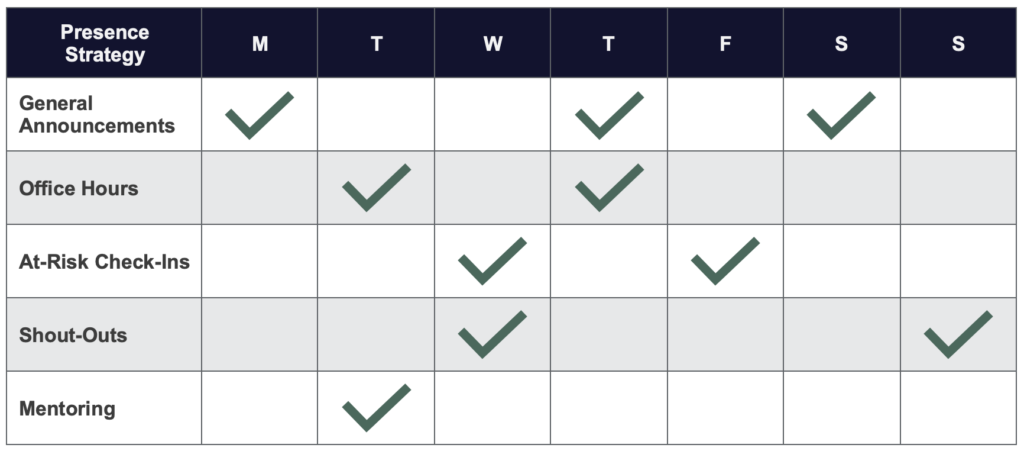
In this example, the instructor has prioritized general announcements for the whole course three times a week. Scheduled office hours are also offered twice a week for all students. Additional shoutouts, either provided in announcements or discussion boards, are scheduled twice a week. The instructor has prioritized individual check-ins for at-risk check-ins as well as mentoring opportunities for interested students.
These individual strategies are best implemented when proactively monitoring student progress. Read on to view additional monitoring strategies.
Step 2: Monitoring Student Progress
In addition to proactively planning your presence, it’s also critical to consider intervention strategies for students who may be struggling. Tracking key milestones that indicate online students’ level of participation and understanding of course materials can prevent them from falling behind or dropping your course. Some key milestones you may consider including are:
- LMS Logins: recency & frequency
- Submission Rate: What percentage of assignments have been submitted weekly?
- Academic Success Rate: Grades on individual items and as a weekly total
Feel free to supplement or replace these milestones with other important indicators in your course. Once you’ve identified milestones, you’ll want to determine levels of success at each milestone. For example, if tracking logins, success levels may look like this:

Tracking these milestones helps you identify which students require outreach. You can then modify your outreach strategy depending on the level of need. In addition, as students progress through the course each week, planned strategies may change and adjust depending on the course and content.
Week 1
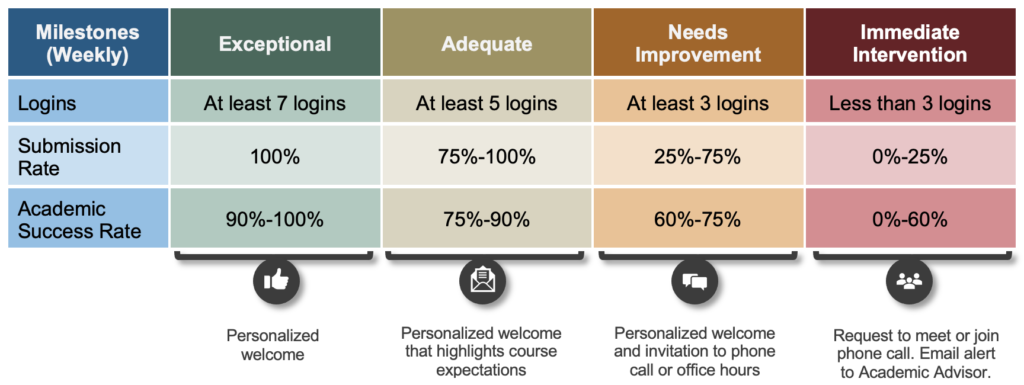
Weeks 2-3
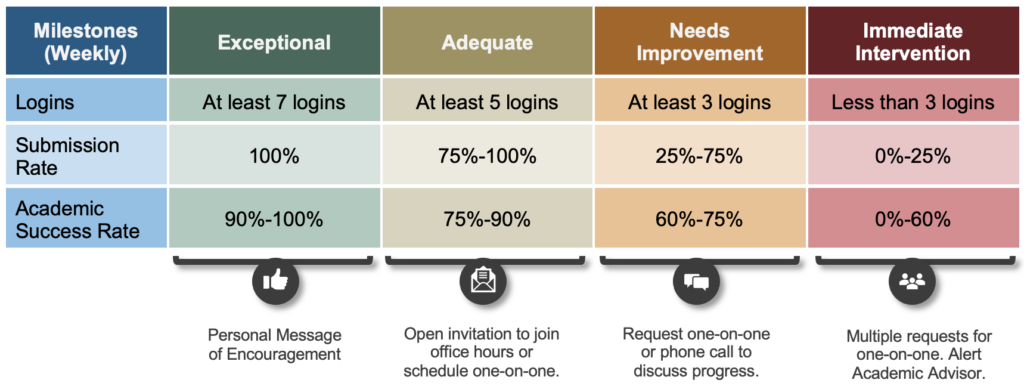
Weeks 4-5
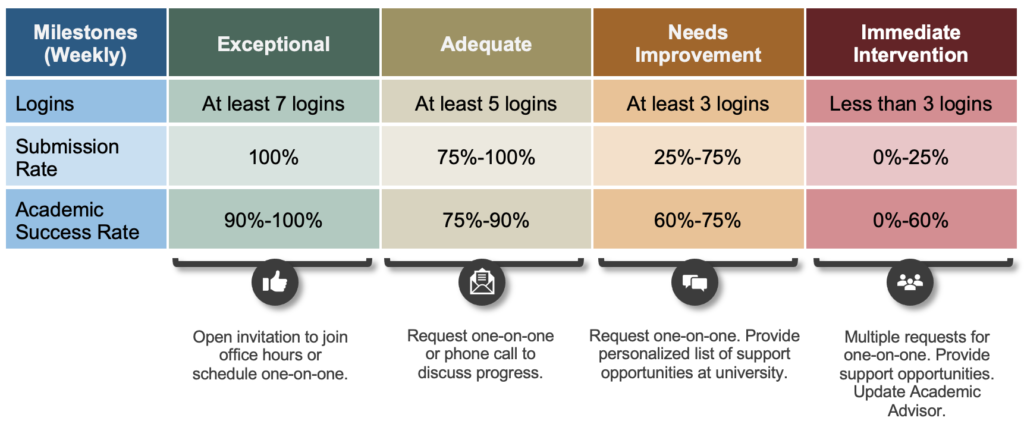
Weeks 5-7
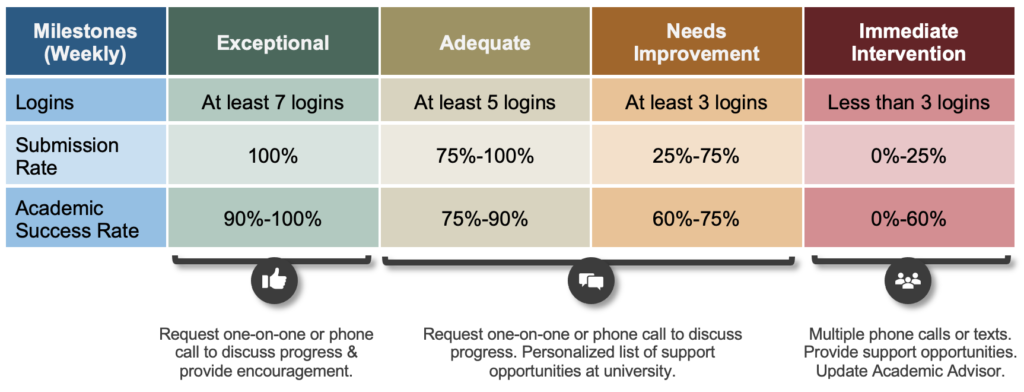
Tracking this data and intervening at key milestones can help you provide optimal support to your students and modify your presence plans for future semesters. In addition, you will have a really excellent set of data that indicates student performance across an entire semester. This can help inform future course revision strategies.
After the course concludes and the semester data has been reviewed, consider the following questions:
- What weeks do logins increase? When do they decrease?
- What weeks have low submission rates? What weeks have high submission rates?
- What weeks have low academic success rates? What weeks have high academic success rates?
- Do you recognize trends between submission rates and academic success rates week over week?
We recommend tracking this information for at least three semesters. Using the answers to the questions above, you can then consider possible revisions to the course based on rigor, alignment, practice, preparation, or provided resources. For example, if a course consistently sees academic success rate decrease in Week 4, possible curriculum revisions could include increased outreach or the addition of a practice assessment in the preceding week. After revisions have been made, continue to track the data for an additional three starts before revising again.
Other Data to Consider
The key milestones discussed above are not the only types of data that can be used to best inform decision-making. Your Learning Management System provides opportunities to run reports to learn more about student performance and activity. Use the links below to explore data and reporting opportunities in your LMS.
- Blackboard Learn: Analytics for Learn | Course Reports
- Blackboard Ultra: Student Activity Details
- Canvas: Course Analytics | New Analytics
- Moodle: Learning Analytics
- Brightspace by D2L: Course Insights

